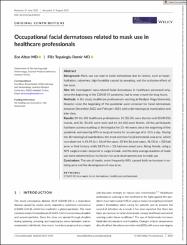Occupational facial dermatoses related to mask use in healthcare professionals
Künye
Altun, E. ve Topaloğlu Demir, F. (2022). Occupational facial dermatoses related to mask use in healthcare professionals. Journal of Cosmetic Dermatology, 21(6), 2535-2541. https://dx.doi.org/10.1111/jocd.14415Özet
Background Mask use can lead to facial dermatoses due to factors, such as hyperhydration, seborrhea, high humidity caused by sweating, and the occlusive effect of the mask. Aim We investigated mask-related facial dermatoses in healthcare personnel who, since the beginning of the COVID-19 pandemic, had to wear a mask for long hours. Methods In this study, healthcare professionals working at Medipol Mega University Hospital since the beginning of the pandemic were screened for facial dermatoses between December 2020 and February 2021 with a dermatological examination and interview. Results Of the 101 healthcare professionals, 51 (50.5%) were doctors and 50 (49.5%) nurses, and 36 (35.6%) were male and 65 (64.4%) were female. All the participants had been actively working at the hospital for 35-46 weeks since the beginning of the pandemic and wearing N95 or surgical masks for an average of 6-13 h a day. During the dermatological examination, the most common facial dermatosis was acne, which was observed in 55.4% (n = 56) of the cases. Of the 56 acne cases, 41.1% (n = 23) had acne in their history, while 58.9% (n = 33) had new-onset acne. Being female, using a N95 surgical mask compared to surgical mask, and the daily average duration of mask use were determined as risk factors for acne development due to mask use. Conclusions The use of masks, more frequently N95, caused both an increase in existing acne and the development of new acne.
WoS Q Kategorisi
Q3Scopus Q Kategorisi
Q2Kaynak
Journal of Cosmetic DermatologyCilt
21Sayı
6Koleksiyonlar
- Makale Koleksiyonu [3770]
- PubMed İndeksli Yayınlar Koleksiyonu [4224]
- Scopus İndeksli Yayınlar Koleksiyonu [6561]
- WoS İndeksli Yayınlar Koleksiyonu [6621]


















